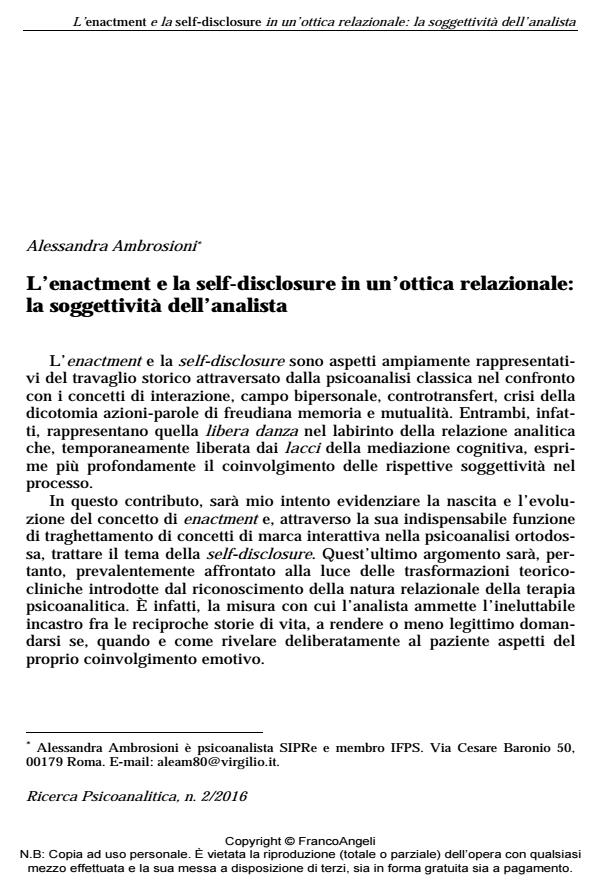Enactment and self-disclosure in a relational view: the analyst’s subjectivity.
Journal title RICERCA PSICOANALITICA
Author/s Alessandra Ambrosioni
Publishing Year 2016 Issue 2016/2 Language Italian
Pages 19 P. 9-27 File size 87 KB
DOI 10.3280/RPR2016-002002
DOI is like a bar code for intellectual property: to have more infomation
click here
Below, you can see the article first page
If you want to buy this article in PDF format, you can do it, following the instructions to buy download credits

FrancoAngeli is member of Publishers International Linking Association, Inc (PILA), a not-for-profit association which run the CrossRef service enabling links to and from online scholarly content.
The Author intends to highlight how the concept of enactment appeared for the first time at a psychodynamic level and then officially in an article by Jacobs in 1986. The term has been formalized by differentiating it from single-person concepts such as acting out and projective identification. Stressing the interactive nature of analytical dialogue, the concept of enactment forced analysts to rearrange the traditional reference theory and to look for shareable basic issues in representation made possible by the APA panel of 1992. The issue of self disclosure will become relevant after the theoretical and clinical changes derived by the recognition of the relational nature of analytical treatment. The question of enactment will also be discussed by the Author in the light of his personal representations, keeping in mind the difference between enactment and interaction, and the complexity and dialectic logic in which this dynamic takes place.
Keywords: Enactment, self-disclosure, acting-out, projective identification, interaction
- Aron L. (1996). Trad. it: Menti che si incontrano. Milano: Raffaello Cortina Editore, 2004.
- Aron L. (2003). The paradoxical place of enactment in Psychoanalysis. Psychoanalytic Dialogues, 13: 623-631. DOI: 10.1080/10481881309348760
- Bass A. (2003). “E” Enactments in Psychoanalysis. Another medium, another message. Psychoanalytic Dialogues, 13: 657-675. DOI: 10.1080/10481881309348762
- Bateman A. W. (1998). Thick and thin skinned organizations and enactment in borderline and narcisistic disorders. International Journal of Psycho-Analysis, 79: 13-25.
- Brice C.W. (2000). Spontaneity versus constraints: dilemmas in the analyst’s decision making. Journal of American Psychoanalytic Association, 48: 549-560. DOI: 10.1177/0003-0651000480020401
- Bromberg M.P. (2006). Trad. it.: Destare il sognatore. Percorsi clinici. Milano: Raffaello Cortina Editore, 2009.
- Cassorla R. M. S. (2001). Acute enactment as a resource in disclosing a collusion between the anlytical dyad. International Journal of Psychoanalysis, 82: 1155-1170. DOI: 10.1516/K79G-FDW3-JFQ3-5FCN
- Chused J. F., Ellman S.J., Renik O., Rothstein A. (1999). Four aspects of the enactment concept: definitions, therapeutic effects, danger, history. Journal of Clinical Psychoanalysis, 8: 9-61.
- Chused J.J. (1997). L’enactment come involontaria attuazione del conflitto inconscio. Commento all’articolo di I. Hirsch. Ricerca Psicoanalitica, 3: 289-304.
- Cooper S.H. (1998). Disclosure e soggettività dell’analista. Ricerca Psicoanalitica, 3: 277-298.
- Cooper S.H. (2008). La privacy dell’analista nel lavoro con il paziente: una rivisitazione dei concetti di neutralità, reverie e disclosure da una prospettiva relazionale. Ricerca Psicoanalitica, 2: 169-190.
- De Marchi A. (2000). Atto ed Enactment. Rivista di Psicoanalisi, 66, 3.
- De Paolis G. (2009). L’enactment nella bibliografia recente. Un concetto ancora utile? Studi junghiani, 15, 2.
- Ferenczi S. (1932). Trad. it.: Diario Clinico. Milano: Raffaello Cortina, 1988.
- Filippini S., Ponsi M. (1993). Enactment. Rivista di Psicoanalisi, 39, 3: 501-516.
- Filippini S., Ponsi M. (1996). Sull’uso del concetto di interazione. Rivista di Psicoanalisi, 42: 566-594.
- Fosshage J.L. (2000). The meanings of touch in Psychoanalysis: a time for reassessment. Psychoanalytic Inquiry, 20: 21-43. DOI: 10.1080/07351692009348873
- Friedmann R.J., Natterson J.M. (1999). Enactments: an intersubjective perspective. Psychoanalytic Quarterly, 68: 220-247. DOI: 10.1002/j.2167-4086.1999.tb00532.x
- Goldberg A. (2002). Enactment as understanding and misunderstanding. Journal of American Psychoanalytic Association, 50: 869-883. DOI: 10.1177/00030651020500030701
- Hirsch I. (1996). Enactment: modello classico e modello interpersonale a confronto. Ricerca Psicoanalitica, n.2/1999: 179-206.
- Hirsch I. (1998). The concept of enactment and theoretical convergence. Psychoanalytic Quarterly, 67: 78-101.
- Hirsch I., (1999). Enactment: convergenza e divergenza. Risposta ai commenti di Chused e Renik. Ricerca Psicoanalitica, 3: 313-322.
- Jacobs T. (1986). On countertransference enactments. Journal of American Psychoanalysis, 34: 289-307. DOI: 10.1177/000306518603400203
- Jacobs T. (1999). On the question of self-disclosure by the analyst: error or advance in technique? The Psychoanalytic Quarterly, 68: 159-183. DOI: 10.1002/j.2167-4086.1999.tb-00529.x
- Jacobs T. (2001). On unconscious communications and covert enactments: some reflections on their role in the analytic situation. Psychoanalytic Inquiry, 21: 4-23. DOI: 10.1080/07351692109348921
- Levenson E. A. (2001). Self-revelation e self-disclosure. Ricerca Psicoanalitica, 3: 277-298.
- Levinson N. A. (2003). Acting out and/or enactment. International Journal of Psychoanalysis, 84: 151-155. doi 10.1516/9G6K-RNRM-B5MX-7GMK.
- Mangini E. (2003). Lezioni sul pensiero post-freudiano. Maestri, idee, suggestioni e fermenti della Psicoanalisi del ‘900. Milano: LED.
- Ponsi M. (1999). La partecipazione dell’analista: un tema emergente nella psicoanalisi nord americana. Rivista di Psicoanalisi, 45: 153-167.
- Renik O. (2001). Giocare a carte scoperte: il problema della self-disclosure. Ricerca Psicoanalitica, 3: 313-329.
- Renik O. (1999). L’enactment al singolare. Commento all’articolo di Irving Hirsch. Ricerca Psicoanalitica, 3: 305-312.
- Sandler J. (1976). Countertransference and role-responsiveness. International Review of Psycho-Analysis, 3: 43-47. Trad. it.: Il controtransfert e risonanza di ruolo, in: Albarella C. e. Donadio M., a cura di, Il controtransfert. Napoli: Liguori, 1998.
- Stolorow R.D. (2003). The therapeutic process and the analyst’s self- disclosures: The good, the bad and the ugly. Israel Psychoanalytic Journal, 1: 89-101.
- Zanocco G., De Marchi A., Pozzi F. (2006). Sensory, empathy and enactment. International Journal of Psychoanalysis, 87: 145-158. DOI: 10.1516/46Y5-AXJQ-YTTE-9VN
Alessandra Ambrosioni, L’enactment e la self-disclosure in un’ottica relazionale: la soggettività dell’analista in "RICERCA PSICOANALITICA" 2/2016, pp 9-27, DOI: 10.3280/RPR2016-002002